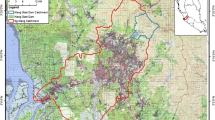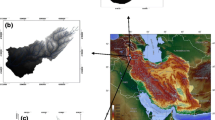Abstract
Rainfall is one of the main variables in several natural disasters such as, floods, drought, groundwater depletion and landslides. Therefore, development of robust models for rainfall forecasting is essential in environmental studies. The chief goal of this research is to use Group Method of Data Handling (GMDH) besides signal processing approaches to forecast rainfall in monthly time steps. To that end, three different signal processing approaches i.e. Ensemble empirical mode decomposition (EEMD), wavelet transform (WT) and wavelet packet transform (WPT) were used combined with GMDH model. Four stations were used to apply aforementioned modeling techniques. Results of this research showed that all three abovementioned signal processing approaches can enhance the ability of the GMDH model. The ability of EEMD-GMDH and wavelet packet-GMDH were relatively close to each other. However, wavelet packet-GMDH outperformed EEMD-GMDH model to some extent. The other important note was the effect of exogenous data on the ability of all models. It was shown that forecasting rainfall without using exogenous data does not produce acceptable results.
Access this chapter
Tax calculation will be finalised at checkout
Purchases are for personal use only
Similar content being viewed by others
References
Adamowski J (2007) Development of a short-term river flood forecasting method based on wavelet analysis. Polish Academy of Sciences Publication, Warsaw, p 172
Adamowski J, Chan FH (2011) A wavelet neural network conjunction model for rainfall forecasting. J Hydrol 407:28–40
Adamowski J, Sun K (2010) Development of a coupled wavelet transform and neural network method for flow forecasting of non-perennial rivers in semi-arid watersheds. J Hydrol 390(1–2):85–91
Aghajani A, Kazemzadeh R, Ebrahimi A (2016) A novel hybrid approach for predicting wind farm power production based on wavelet transform, hybrid neural networks and imperialist competitive algorithm. Energ Convers Manageme 121:232–240
Alves MdC, Pozzab EA, Costac JCB, Carvalhod LG, Alvese LS (2011) Adaptive neuro-fuzzy inference systems for epidemiological analysis of soybean rust. Environ Modell Softw 26(9):1089–1096
Alvisi S, Franchini M (2011) Fuzzy neural networks for water level and discharge forecasting with uncertainty. Environ Modell Softw 26(4):523–537. http://www.sciencedirect.com/science/journal/13648152/26/4
Amanifard N, Nariman-Zadeh N, Farahani MH, Khalkhali A (2008) Modelling of multiple short-length-scale stall cells in an axial compressor using evolved GMDH neural networks. J Energy Convers Manage 49(10):2588–2594
Breaker LC, Ruzmaikin A (2011) The 154-year record of sea level at San Francisco: extracting the long-term trend, recent changes, and other tidbits. Clim Dyn 36(3–4):545–559
Cannas B, Fanni A, Sias G, Tronei S, Zedda MK (2006) River flow forecasting using neural networks and wavelet analysis. In: Proceedings of the European Geosciences Union. 234–243
Christopoulou EB, Skodras AN, Georgakilas AA (2002) The ‘‘Trous’’ wavelet transform versus classical methods for the improvement of solar images. In: Proceedings of 14th international conference on digital signal processing, vol. 2, pp. 885–888
Daliakopoulos IN, Coulibaly P, Tsanis IK (2005) Rainfall forecasting using artificial neural networks. J of Hydrol 309:229–240
Daubechies L (1990) The wavelet transform, time-frequency localization and signal analysis. IEEE Trans Inform Theory 36:961–1005
Fallah-Mehdipour E, Bozorg Haddad O, Mariño MA (2013) Prediction and simulation of monthly rainfalls by genetic programming. J Hydro Environ Res 7(4):253–260
Farlow SJ (1984) Self -organizing method in modeling. Marcel Dekker Inc, GMDH Type Algorithm
Feng Z, Liang M, Zhang Y, Hou S (2012) Fault diagnosis for wind turbine planetary gearboxes via demodulation analysis based on ensemble empirical mode decomposition and energy separation. Renew Energy 47:112–126
Garcia C, Zikos G, Tziritas G (2000) Wavelet packet analysis for face recognition. Image Vision Comput 18:289–297
Guo W, Tse PW (2013) A novel signal compression method based on optimal ensemble empirical mode decomposition for bearing vibration signals. J Sound Vib 332:423–441
Han J, Zheng P, Wang H (2014) Structural modal parameter identification and damage diagnosis based on Hilbert-Huang transform. Earthquake Eng Vib 13:101–111
He Z, Wen X, Liu H, Du J (2014) A comparative study of artificial neural network, adaptive neuro fuzzy inference system and support vector machine for forecasting river flow in the semiarid mountain region. J Hydrol 509:379–386
Ivakhnenko AG (1966) Group method of data handling—a rival of the method of stochastic approximation. Sov Autom Cont 13:43–71
Ivakhnenko AG (1971) Polynomial theory of complex systems. IEEE Trans Syst Man Cybern Syst 1(4):364–378
Kalantary F, Ardalan H, Nariman-Zadeh N (2009) An investigation on the Su–NSPT correlation using GMDH type neural networks and genetic algorithms. Eng Geol 104:144–155
Kim Y, Shin HS, Plummer JD (2014) A wavelet-based autoregressive fuzzy model for forecasting algal blooms. Environ Modell Softw 62:1–10
Kisi O (2009) Neural networks and wavelet conjunction model for intermittent stream flow forecasting. J Hydrol Eng 14:773–782
Li X, Maier HR, Zecchin AC (2015) Improved PMI-based input variable selection approach for artificial neural network and other data driven environmental and water resource models. Environ Modell Softw 65:15–29
Liu H, Chen C, Hq Tian, Li Y (2012) A hybrid model for wind speed prediction using empirical mode decomposition and artificial neural networks. Renew Energ 48:545–556
Mackay JD, Jackson CR, Wang L (2014) A lumped conceptual model to simulate rainfall time-series. Environ Modell Softw 61:229–245
Manjula M, Sarma AVRS (2012) Comparison of Empirical Mode Decomposition and Wavelet Based Classification of Power Quality Events. Energy Procedia 14:1156–1162
Mariyappa N, Sengottuvel S, Parasakthi C (2014) Baseline drift removal and denoising of MCG data using EEMD: role of noise amplitude and the thresholding effect. Med Eng Phys 36(10):1266–1276
Mehra RK (1977) Group method of data handling (GMDH): Review and experience. IEEE conf dec cont 16:29–34
Mehrara M, Moeini A, Ahrari M, Erfanifard A (2009) Investigating the efficiency in oil futures market based on GMDH approach. Expert Syst Appl 36(4):7479–7483
Millie DF, Weckman GR, Young WA, Ivey JE, Carrick HJ, Fahnenstiel GL (2012) Modeling microalgal abundance with artificial neural networks: Demonstration of a heuristic ‘Grey-Box’ to deconvolve and quantify environmental influences. Environ Modell Softw 27–39
Moosavi V, Niazi Y (2015) Development of Hybrid Wavelet Packet-Statistical Models (WP-SM) for landslide susceptibility mapping. Landslides 13(1):97–114. https://doi.org/10.1007/s10346-014-0547-0
Moosavi V, Talebi A, Mokhtari MH, Fallah Shamsi SR, Niazi Y (2015) A Wavelet-Artificial Intelligence Fusion Approach (WAIFA) for Blending Landsat and MODIS surface temperature. Remote Sens Environ 169:243–254
Moosavi V, Vafakhah M, Shirmohammadi B, Behnia N (2013) A Wavelet-ANFIS hybrid model for rainfall forecasting for different prediction periods. Water Resour Manag 27:1301–1321
Moosavi V, Vafakhah M, Shirmohammadi B, Ranjbar B (2014) Optimization of Wavelet-ANFIS and Wavelet-ANN Hybrid Models by Taguchi Method for Rainfall forecasting. Arab J Sci Eng 39:1785–1796
Najafzadeh M (2015) Neuro-fuzzy GMDH systems based evolutionary algorithms to predict scour pile groups in clear water conditions. Ocean Eng 99:85–94
Najafzadeh M, Barani GA, Hessami Kermani MR (2013) GMDH based back propagation algorithm to predict abutment scour in cohesive soils. Ocean Eng 59:100–106
Najafzadeh M, Lim SY (2015) Application of improved neuro-fuzzy GMDH to predict scour depth at sluice gates. Earth Sci Inform 8(1):187–196
Nourani V, Alami MT, Aminfar MH (2009) A combined neural-wavelet model for prediction of Ligvanchai watershed precipitation. Eng Appl Artif Intell 22:466–472
Nourani V, Kisi Z, Mehdi K (2011) Two hybrid artificial Intelligence approaches for modeling rainfall-runoff process. J Hydrol 402:41–59
Pal S, Devara PCS (2012) A wavelet-based spectral analysis of long-term time series of optical properties of aerosols obtained by lidar and radiometer measurements over an urban station in Western India. J Atmos Sol-Rerr Phy Solar-Terrestrial Phys 84–85:75–87
Quiroz R, Yarlequé Ch, Posadas A, Mares V, Immerzeel WW (2011) Improving daily rainfall estimation from NDVI using a wavelet transform. Environ Modell Softw 26(2):201–209
Ravisankar P, Ravi V (2010) Financial distress prediction in banks using Group Method of Data Handling neural network, counter propagation neural network and fuzzy ARTMAP. Knowl-Based Sys 23:823–831
Sànchez-Marrè M, Cortés U, Comas J (2004) Environmental sciences and artificial intelligence. Environ Modell Softw 19(9):761–762
Si J, Feng Q, Wen X, Xi H, Yu T, Li W, Zhao C (2015) Modeling soil water content in extreme arid area using an adaptive neuro-fuzzy inference system. J of Hydrol 527:679–687
Sreekanth P, Geethanjali DN, Sreedevi PD, Ahmed S, Kumar NR, Jayanthi PDK (2009) Forecasting rainfall using artificial neural networks. Current Sci 96(7):933–939
Talei A, Chua LHC, Wong TSW (2010) Evaluation of rainfall and discharge inputs used by Adaptive Network-based Fuzzy Inference Systems (ANFIS) in rainfall–runoff modeling. J of Hydrol 391(3–4):248–262
Volterra V (1959) Theory of functionals and of integrals and integro-differential equations. Madrid (Spanish), translated version reprinted New York: Dover Publications
Wieland R, Mirschel W, Zbell B, Krin Groth K, Pechenick A, Fukuda K (2010) A new library to combine artificial neural networks and support vector machines with statistics and a database engine for application in environmental modeling. Environ Modell Softw 25(4):412–420
Witczak M, Korbicz J, Mrugalski M, Patton R (2006) A GMDH neural networkbased approach to robust fault diagnosis: application to the DAMADICS benchmark problem. Control Eng Pract 14(6):671–683
Wu Zh, Huang Zh (2009) Ensemble empirical mode decomposition: a noise-assisted data analysis method. Adv Adapt Data Anal 1:1–41
Yoon H, Hyun Y, Ha K, Lee KK, Kim GB (2016) A method to improve the stability and accuracy of ANN- and SVM based time series models for long-term rainfall predictions. Comput Geosc 90:144–155
Yoon H, Jun SC, Hyun Y, Bae GO, Lee KK (2011) A comparative study of artificial neural networks and support vector machines for predicting rainfalls in a coastal aquifer. J of Hydrol 396:128–138
Young WA, Millie DF, Weckman GR, Anderson JS, Klarer DM, Fahnenstiel GL (2011) Modeling net ecosystem metabolism with an artificial neural network and Bayesian belief network. Environ Modell Softw 26(10):1199–1210
Yu Y, Li W, Sheng D, Chen J (2015) A novel sensor fault diagnosis method based on modified ensemble empirical mode decomposition and probabilistic neural network. Measurement 68:328–336
Zhan X (2005) Parallel Fortran-MPI software for numerical inversion of the Laplace transform and its application to oscillatory water levels in groundwater environments. Environ Modell Softw 20(3):279–284
Zhao JP, Huang DJ (2001) Mirror extending and circular spline function for empirical mode decomposition method. J Zhejiang Univ Sci 2(3):247–252
Author information
Authors and Affiliations
Corresponding author
Editor information
Editors and Affiliations
Rights and permissions
Copyright information
© 2019 Springer Nature Switzerland AG
About this chapter
Cite this chapter
Moosavi, V. (2019). Prediction of Rainfall as One of the Main Variables in Several Natural Disasters. In: Pourghasemi, H., Rossi, M. (eds) Natural Hazards GIS-Based Spatial Modeling Using Data Mining Techniques. Advances in Natural and Technological Hazards Research, vol 48. Springer, Cham. https://doi.org/10.1007/978-3-319-73383-8_8
Download citation
DOI: https://doi.org/10.1007/978-3-319-73383-8_8
Published:
Publisher Name: Springer, Cham
Print ISBN: 978-3-319-73382-1
Online ISBN: 978-3-319-73383-8
eBook Packages: Earth and Environmental ScienceEarth and Environmental Science (R0)




